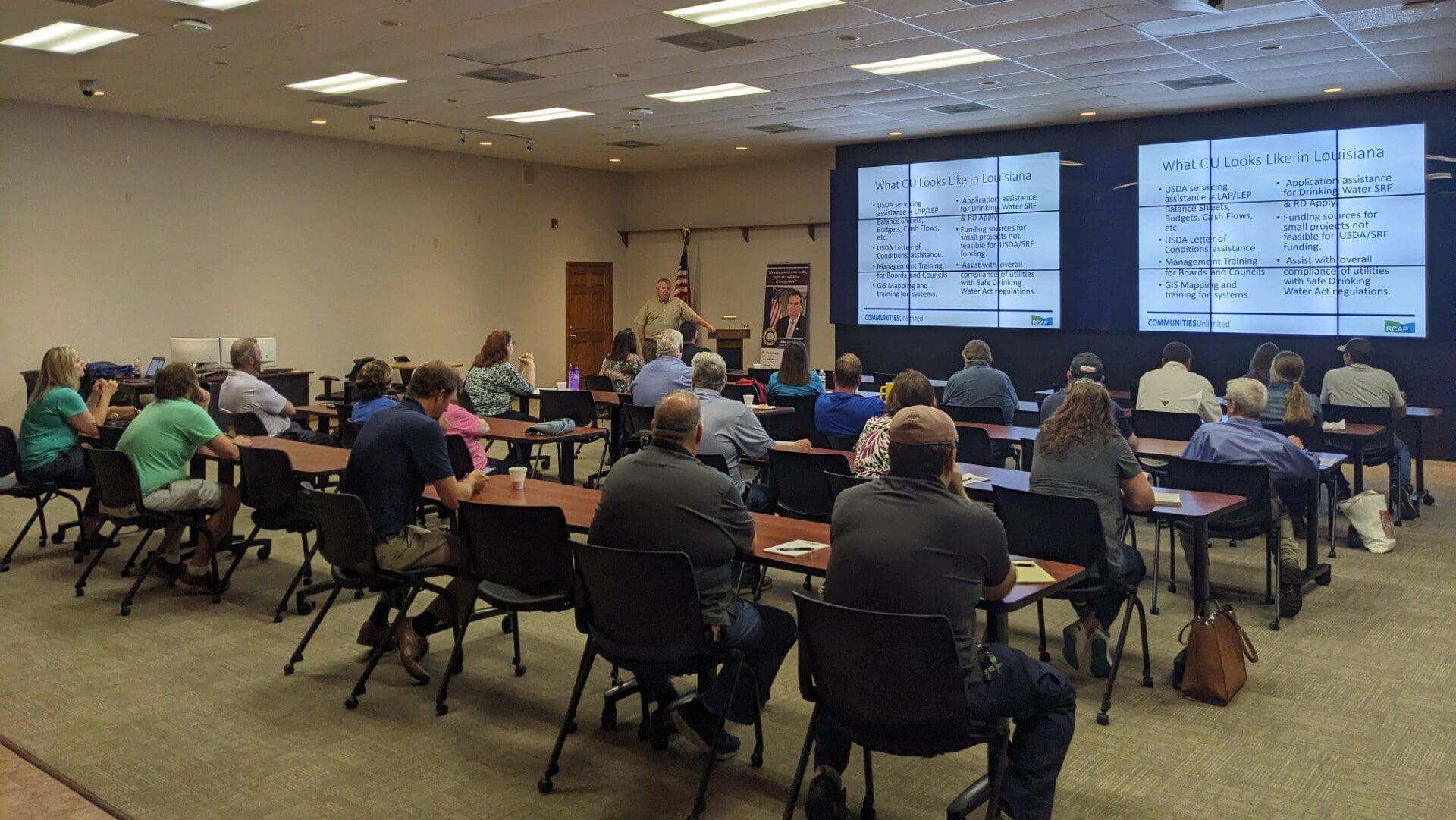Across the United States, under the new Lead and Copper Rule, all water systems were tasked with identifying both system-owned and customer-owned service line materials by Oct. 16, 2024. This was a monumental task for all systems. Smaller systems, the ones the Community Infrastructure Team at Communities Unlimited (CU) typically works with, often lack the capacity and knowledge to complete these inventories.
Recognizing the magnitude of the challenge, CU Louisiana State Coordinator Chris Brunson saw a partnership with Louisiana Department of Health Compliance Engineer Jeremy Harris as the best way to assist numerous communities. Thus began the Lead Service Line Inventory (LSLI) trainings across Louisiana.

CU conducted five trainings, with four of the five sessions reaching full attendance. As the trainings progressed, the quality of questions improved, highlighting nuances that only arise once systems have started their inventories. Some systems attended more than one session and even sought online training to further grasp the process.
There was considerable confusion surrounding the first steps of the survey, identifying service line materials, downloading and submitting the inventory, legal concerns about being on customers’ properties, navigating Excel sheets, and what to do if systems lacked water records. Other questions involved how to handle upcoming water meter projects, the use of predictive or statistical analysis, whether the survey had to be online, whether lead pigtails or connectors counted as lead service lines, and whether systems installed after the lead ban still needed to complete the survey. The list of questions went on.
Throughout the training of 185 individuals across Louisiana, we received numerous assistance requests from small systems. Chris and I, both Technical Assistance Providers (TAPs), helped 10 water systems with their inventories. One system only needed questions answered, but the others required far more support.
I worked closely with several systems, coordinating with their software representatives to download service addresses onto Excel sheets. I added those addresses to a customized sheet with columns to collect the necessary data so that operators could take printed copies into the field. Once the field data was collected, I entered it into the LSLI inventory template. I visited most of these systems the day before their inventories were due, ensuring everything was in order before submission to the LDH LSLI online portal.
It was a relief for the system operators, clerks, and CU TAPs to have all these lead service line inventories completed and uploaded. If a system fails to submit this inventory, it risks being noncompliant with LDH and EPA regulations.
This rule is crucial for protecting U.S. citizens, as the findings will be made publicly available and will show where lead service lines exist or once existed. In the coming years, all lead service lines must be replaced to reduce or eliminate drinking water contamination. CU is proud to help these communities in such meaningful ways, many of which are now called friends.

“On behalf of Point Blue/Chataignier Water System and the City of Ville Platte Water System, I’d like to thank Stacey Scarce for her training and assistance with LSLI. She was a tremendous help and made the survey process much easier. Thank you again for your support, Stacey.”
— Keith Saucier, Water Operator at Point Blue / Chataignier Water System
“I appreciate this greatly,” said Clerk Ann Heck. “I was going to have to retire because I didn’t understand the LSLI spreadsheet. I’m so grateful for Chris’ help.”
Additionally, CU’s Infrastructure Staff in Alabama conducted five training sessions on the Lead & Copper Rule Revisions (LCRR), which required the completion of the Service Line Inventory by Oct. 16.
Dinah Foreman, CU Alabama State Coordinator, facilitated four of these sessions online and hosted one in-person class, with staff from the Alabama Department of Environmental Management (ADEM) presenting the LCRR rule and detailing the requirements for the Service Line Inventory.
A total of 94 participants from 42 water systems attended these classes. Each session covered general LCRR requirements and provided detailed instructions on completing the state-specific spreadsheet and certification form that water systems needed to submit. In addition, Alabama staff offered guidance and direct assistance to seven project water systems to help them complete their Service Line Inventory.
In Tennessee, CU Source Water Project Manager Brett Capps led the efforts to assist small water systems with the LSLI requirement. Brett worked closely with the Copperhill Water and Wastewater System to compile and submit their inventory. Copperhill benefitted from a prior meter replacement project, which allowed the system to quickly confirm that its distributor lines were PVC. Over the spring and summer of 2024, Copperhill conducted field inspections and logged connection materials, while Brett provided hands-on support and ensured the final inventory met all submission requirements for the Tennessee Department of Environment and Conservation (TDEC).
This collaborative approach, spanning seven states, highlights CU’s commitment to empowering small systems to navigate complex federal regulations, safeguard public health, and tackle the vital challenge of lead service line replacement. Louisiana, Alabama, and Tennessee serve as key examples of how CU’s work directly impacts communities, ensuring compliance and readiness for this critical undertaking.

This article was crafted by Stacey Scarce, Community Environmental Management Specialist on our Infrastructure Team. Fellow TAPs Dinah Foreman and Brett Capps contributed to this article. Communities Unlimited’s Community Infrastructure Team is compromised of many years of service in water and wastewater. We are the southern affiliate of RCAP (Rural Community Assistance Partnership). We provide technical, managerial, and financial assistance to Alabama, Arkansas, Louisiana, Mississippi, Oklahoma, Tennessee, and Texas.

